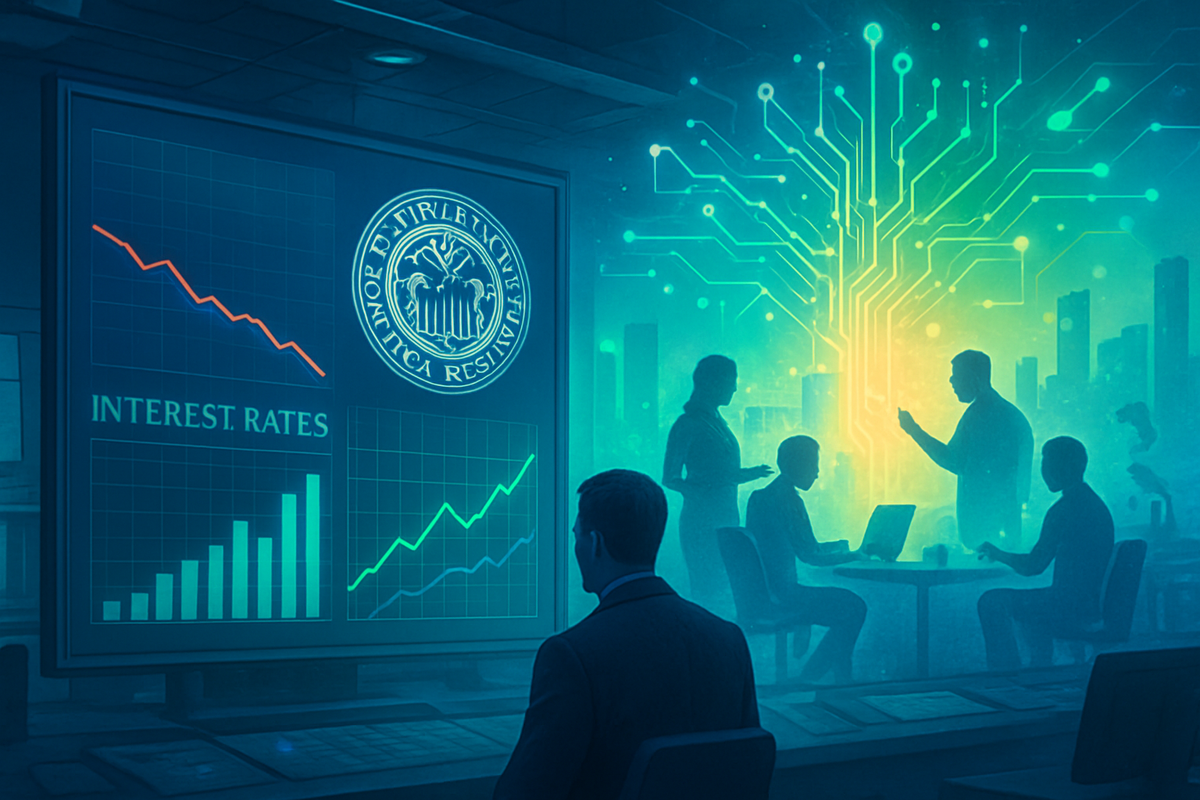Financial News
Tech Sector Braces for Boost as Federal Reserve Poised for October Rate Cut

Anticipation Builds for Monetary Easing Amid Economic Headwinds
The financial markets are abuzz with fervent anticipation as the Federal Reserve is widely expected to enact another interest rate cut at its upcoming Federal Open Market Committee (FOMC) meeting on October 28-29, 2025. This potential move, following a prior reduction in September 2025, is primarily driven by concerns over a softening labor market and the economic drag from an ongoing government shutdown. While broader economic implications are being carefully weighed, the prospect of lower borrowing costs has particularly ignited a wave of optimism across the technology sector, which stands to benefit significantly from more accessible and cheaper capital.
This expected monetary easing comes at a critical juncture, as the Fed navigates a complex economic landscape characterized by persistent, albeit moderating, inflation and signs of deceleration in employment growth. For the tech industry, a sector historically reliant on investment and future growth projections, a rate cut could serve as a powerful tailwind, potentially unlocking new avenues for expansion, innovation, and increased valuations.
The Looming Cut: Rationale and Expected Market Tremors
The widespread expectation of an October 2025 rate cut stems from a confluence of economic indicators and the Federal Reserve's stated dual mandate of maximizing employment and maintaining price stability. Key among the concerns is a perceptible weakening in the labor market. Reports indicate that job growth has nearly stalled over the summer, and private-sector data points to underlying fragility, prompting the Fed to consider measures to stimulate hiring and preempt a significant rise in unemployment. This focus on employment stability appears to be taking precedence, even as the Consumer Price Index (CPI) registered 3% year-over-year in September, slightly above the Fed's 2% target.
Adding to the complexity is the current government shutdown, which has not only delayed the release of critical economic data but is also projected to impose a direct drag on real GDP growth. The Fed's anticipated rate reduction is seen as a pre-emptive strike to mitigate these economic headwinds. The timeline leading up to this moment includes a previous rate cut in September 2025, marking the Fed's first reduction since December 2024, signaling a clear shift towards an accommodative monetary policy stance. Key players in this decision-making process include Federal Reserve Chair Jerome Powell and the members of the FOMC, whose public statements and economic projections have heavily influenced market expectations.
Initial market reactions to the prospect of a rate cut have been largely positive, especially in equity markets. Lower interest rates typically make stocks more attractive compared to fixed-income investments, and they can boost corporate profitability by reducing borrowing costs. For the tech sector, this translates into an even more pronounced sense of optimism. Technology companies, often characterized by high growth potential and significant capital expenditure on research and development, thrive in environments where funding is readily available and affordable. The anticipation of cheaper capital has already begun to fuel positive sentiment, with investors eyeing potential boosts to valuations and increased investment in innovation.
Tech Titans and Agile Startups: Who Wins and Who Faces Headwinds?
The anticipated Federal Reserve rate cut is poised to create distinct winners and losers across the financial landscape, with the tech sector largely positioned to reap significant benefits. Companies heavily reliant on external financing for aggressive growth, research and development, and mergers and acquisitions will likely be the primary beneficiaries. This includes many high-growth technology firms, particularly those in nascent or rapidly expanding sub-sectors like artificial intelligence, cloud computing, and biotechnology, which often operate with negative cash flows in their early stages and depend on readily available capital.
Growth stocks, a category dominated by technology companies, typically see their valuations improve as interest rates fall. Lower discount rates increase the present value of future earnings, which is particularly impactful for tech companies whose valuations are often predicated on long-term growth trajectories rather than immediate profitability. Giants like Microsoft (NASDAQ: MSFT), Amazon (NASDAQ: AMZN), and Alphabet (NASDAQ: GOOGL), which continually invest in new technologies and infrastructure, could see reduced costs for their massive capital expenditures and potentially higher returns on their extensive R&D efforts. Smaller, innovative startups, often venture-capital-backed, will also find it easier and cheaper to secure funding rounds, accelerating their development and market entry.
Conversely, some sectors and financial instruments may experience headwinds. Traditional banks, for instance, might see their net interest margins compressed as the difference between what they earn on loans and what they pay on deposits narrows. Savers relying on interest income from Certificates of Deposit (CDs) and high-yield savings accounts will likely see their returns diminish. While the overall market sentiment is bullish for equities, companies with significant debt but limited growth prospects might not see the same uplift, as the underlying business fundamentals remain paramount. However, for the tech sector as a whole, the prevailing sentiment is overwhelmingly positive, driven by the prospect of a more favorable financing environment.
Broader Implications and Historical Echoes
The Federal Reserve's anticipated October 2025 rate cut is not an isolated event but rather a significant move within a broader economic narrative defined by a delicate balancing act between stimulating growth and managing inflation. This potential easing of monetary policy fits into a global trend where central banks are grappling with uneven economic recoveries and localized pressures. For the tech industry, this event underscores its sensitivity to the cost of capital and its role as a bellwether for market sentiment when monetary conditions shift.
The ripple effects of such a cut could extend beyond direct financing. Lower interest rates can encourage increased consumer spending, particularly on discretionary items, including technology products and services. This could boost demand for consumer electronics, software subscriptions, and digital platforms, benefiting companies like Apple (NASDAQ: AAPL) and Netflix (NASDAQ: NFLX). Furthermore, the move could encourage mergers and acquisitions within the tech space, as larger companies find it cheaper to finance buyouts of smaller innovators, leading to further industry consolidation and strategic realignment. Regulatory implications might also emerge, as policymakers observe how this liquidity infusion impacts market stability and potential asset bubbles, especially in a high-growth sector like tech.
Historically, periods of lower interest rates have often coincided with robust growth in the technology sector. The late 1990s dot-com boom, while ultimately unsustainable, was fueled in part by readily available and cheap capital. More recently, the decade following the 2008 financial crisis saw sustained low-interest rates contribute to an unprecedented bull run for tech stocks, enabling massive investments in cloud infrastructure, mobile technology, and software-as-a-service (SaaS) models. While the current environment differs, the fundamental principle remains: cheaper money often translates to greater investment and higher valuations for growth-oriented companies. This historical precedent reinforces the current optimism, albeit with a cautious eye towards sustainable growth.
What Comes Next: Navigating the New Monetary Landscape
Looking ahead, the anticipated Federal Reserve rate cut sets the stage for several short-term and long-term possibilities across the financial markets, with particular resonance for the tech sector. In the immediate aftermath of a confirmed cut, markets are likely to experience an initial surge of positive sentiment, potentially driving equity prices higher, especially for growth-oriented tech stocks. Companies that have been deferring significant capital expenditures or M&A activities due to higher borrowing costs may accelerate those plans, leading to increased investment in innovation and expansion.
In the short term, we could see a renewed focus on venture capital funding and initial public offerings (IPOs) within the tech space, as investors become more willing to fund promising, albeit not yet profitable, ventures. Companies may also strategically pivot their financing strategies, opting for more debt-based funding over equity dilution. However, the long-term outlook will depend on whether this rate cut genuinely stimulates sustainable economic growth without reigniting inflationary pressures. If the Fed's actions successfully stabilize the labor market and mitigate economic drag, the tech sector could enjoy an extended period of favorable financing conditions.
Potential challenges include the risk of overheating in certain tech sub-sectors, leading to inflated valuations that are not supported by fundamental earnings. Investors will need to discern between genuine growth opportunities and speculative bubbles. Market opportunities will likely emerge in areas requiring significant upfront investment, such as advanced AI research, quantum computing, and sustainable technologies, where the cost of capital is a critical factor. Strategic adaptations will be crucial for companies to leverage this environment effectively, focusing on efficient capital allocation and clear pathways to profitability. Scenarios could range from a steady, sustained tech rally to a more volatile period if economic data remains ambiguous or if further rate adjustments become necessary.
The Road Ahead: A Tech-Driven Market in Focus
The anticipated October 2025 Federal Reserve rate cut stands as a pivotal moment for the financial markets, particularly for the technology sector. The key takeaway is the Fed's apparent prioritization of employment stability and economic growth in the face of ongoing headwinds, signaling a more accommodative monetary policy stance. For tech companies, this translates into a potentially significant reduction in the cost of capital, fostering an environment conducive to investment, innovation, and expansion.
Moving forward, the market will be closely watching for the Fed's official announcement and subsequent forward guidance. Investors should assess individual tech companies not just on their growth narratives but also on their balance sheets, debt exposure, and ability to effectively deploy cheaper capital for sustainable value creation. While the immediate outlook for tech appears bright, driven by the prospect of lower borrowing costs and increased investor appetite for growth, vigilance is paramount.
The lasting impact of this potential rate cut will hinge on its ability to truly stimulate the broader economy without triggering adverse inflationary spirals. What investors should watch for in the coming months includes further labor market data, inflation reports, and any shifts in the Fed's rhetoric regarding future monetary policy. The tech sector, with its inherent dynamism and reliance on innovation, is uniquely positioned to capitalize on this evolving financial landscape, but prudent decision-making and a focus on fundamental strength will be crucial for navigating the opportunities and challenges ahead.
This content is intended for informational purposes only and is not financial advice
More News
View More




Recent Quotes
View More
Quotes delayed at least 20 minutes.
By accessing this page, you agree to the Privacy Policy and Terms Of Service.



